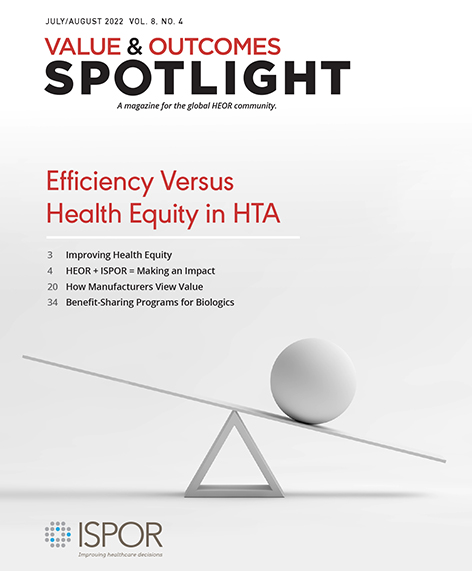Research Roundup
Section Editor: Aakash Bipin Gandhi, BPharm, PhD, Research Scientist, RWE, Sanofi, Cambridge, MA, USA
Inclusion in health technology assessments: the first step toward equity.
Frank L, Concannon TW. Health Affairs Blog. November 10, 2021.
Summary
This piece discusses the inclusion of equity considerations in health technology assessments (HTAs). Importantly, the role of quality-adjusted life years (QALYs) in HTAs and ethical concerns regarding their impact on equity considerations are discussed in detail. For example, individuals with lived experiences (ie, chronically ill, disabled, or older adult populations) usually are not recruited for surveys that guide QALY-based HTAs. This is due to the assumption that individuals with lived experiences may overstate the value of interventions that they may receive for their care. Currently, QALYs depend on societal-level experiences and associated estimates to measure the value to be placed on different disease conditions and interventions. However, adopting this approach may understate utility estimates stated by those with lived experiences. For example, societal estimates of utilities may greatly undervalue disability care.
Relevance
Significant changes in the design of HTAs, including addressing exclusion of key populations, accounting for societal-level biases, and taking steps to tackle structural racism are required to address inequities in healthcare. Collecting the perspectives of all patients, including those with lived experiences, will help provide a comprehensive and unbiased estimate of the value they place on disease conditions, interventions, and healthcare outcomes.
An equity framework for health technology assessments.
Culyer AJ, Bombard Y. Medical Decision Making. 2012;32(3):428-441.
Summary
The present study discusses the importance of considering equity criteria while framing HTAs and proposes a checklist of equity items that decision makers should consider in HTAs. These items include but are not limited to addressing institutional bias, implicit stereotyping, equity-related consequences of categorizing individuals into subgroups, and accounting for legal obligations related to discrimination on the grounds of race/ethnicity, age, gender, disability, nationality, language, and sexual orientation. While the framework is not intended to be considered as a standard in the field, it has been designed with the objective of taking the first step towards guiding healthcare decision makers to prioritize a list of equity components that they should consider incorporating within HTAs. The framework proposed in this article can also complement existing equity frameworks or aid an organization’s auditing processes that ensure the inclusion of equity considerations within HTAs.
Relevance
Frameworks and checklists proposed in the present article can provide a systematic and comprehensive capture of equity items that healthcare planners can consider to be included in HTAs.
Assessments of the value of new interventions should include health equity impact.
Jansen JP, Trikalinos TA, Phillips KA. PharmacoEconomics. 2022;40(5): 489-495
Summary
This study discusses the formal health equity impact of a new intervention for Alzheimer’s disease, aducanumab, which was recently approved by the United States Food and Drug Administration. Despite its recent approval and consequent lack in availability of supporting data, the authors propose a distributional cost-effectiveness approach to quantify its health equity impact. The authors find that relative to standard of care, aducanumab can increase overall health when priced at $10,000 per year. However, there would be an increase in inequity for health outcomes when considering subgroups defined by race/ethnicity.
Relevance
Quantitative assessments of the impact of new interventions on health equity can help healthcare planners make better coverage decisions, improve program designs, and develop quality initiatives targeted at the entire population without excluding any key subgroups. Further, limited participation of racial and ethnic minorities in clinical trials associated with drug approval (such as in the case of aducanumab to treat Alzheimer’s disease) does not preclude quantitative assessments related to health equity in these populations. Quantifying uncertainties associated with the health equity of an existing intervention can help facilitate its fair pricing and guide future research priorities. Population-level decision making with the objective of improving total health requires regular assessments of health equity impact of new treatments.
Note from the Section Editor: Views, thoughts, and opinions expressed in this section are my own and not those of any organization, committee, group, or individual that I am affiliated with.

